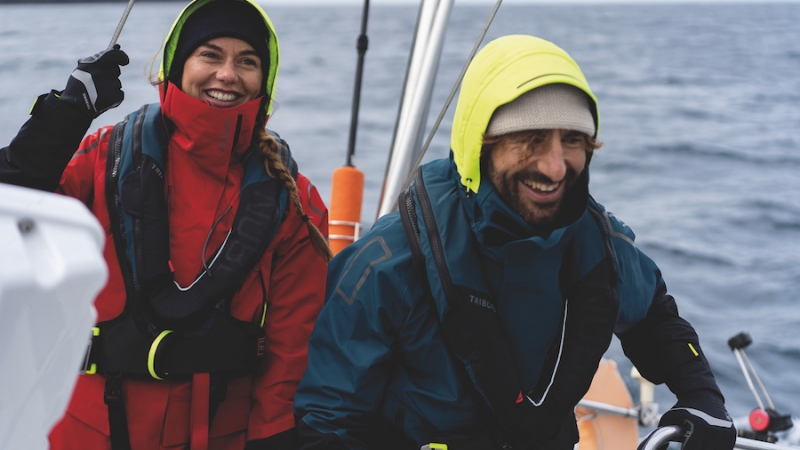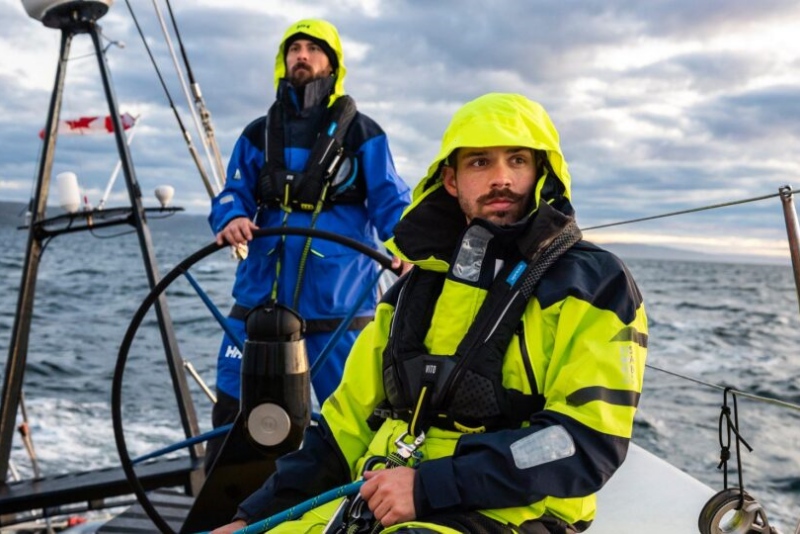What Is A Waterproof Sailing Jacket
If you love sailing, you know the importance of having the right sailing wear. The open sea presents unique challenges—harsh winds, unpredictable weather, and constant exposure to water. To stay comfortable and protected, a waterproof sailing jacket is a must-have piece of equipment.
Having accumulated 17 years of experience in clothing design and delving extensively into sailing equipment, BOWINS Garment is thrilled to present you with this in-depth manual. Our objective is to outline the crucial characteristics of an sailing jacket, underscore the significance of attaining the ideal fit, and provide insightful recommendations for choosing the perfect sailing jacket tailored to your individual requirements.
But what exactly is a waterproof sailing jacket? How does it differ from a regular sailing jacket? And how do you choose the best one for your adventures? This guide will answer all your questions and help you find the perfect sailing jacket for your needs.
1. What is a Waterproof Sailing jacket?
A waterproof sailing jacket is an essential outerwear garment designed to protect sailors from harsh maritime conditions, including rain, sea spray, and strong winds. Made from advanced waterproof and breathable materials to ensure water resistance while allowing internal moisture (sweat) to escape, keeping the wearer dry and comfortable.
Key features of a sailing jacket include sealed seams, adjustable hoods, and high collars for maximum protection. Double cuffs and wrist seals prevent water from entering, while reinforced areas on the shoulders and elbows enhance durability. Many jackets also feature reflective elements for visibility in low-light conditions and large, water-resistant pockets with drainage.
A waterproof sailing jacket is essential for maintaining warmth, dryness, and mobility on the water, ensuring safety and comfort in unpredictable marine environments. Whether for leisure or competition, it is a vital piece of gear for any sailor.
2. What Are the Functions of a waterproof Sailing Jacket?
A waterproof sailing jacket serves several critical functions beyond just keeping you dry. Here are the main features that make it an essential part of any sailor’s gear:
2.1 Waterproof Protection
The most fundamental function of a sailing jacket is waterproofing. It prevents water from soaking through, keeping you dry even in heavy rain or ocean spray. High-quality sailing jackets use:
The main fabric of waterproof sailing jackets is composed of 228T nylon taffeta + PTFE membrane compound 30D Taslon. or other waterproof membranes to block water while allowing breathability.sealed and taped seams to prevent leaks.Waterproof zippers to ensure no moisture seeps through.
2.2 Windproof Barrier
Strong winds are common at sea, and a sailing jacket acts as a windproof shield to reduce heat loss. Features like high collars, storm flaps, and adjustable cuffs help block out cold air.
2.3 Breathability for Comfort
2.3.1 Breathability Ratings
Moisture Vapor Transmission (MVT) or Moisture Vapor Permeability (MVP): This measures the amount of water vapor that can pass through a square meter of fabric over 24 hours. A rating of more than 8,000g/m²/24 hours is considered good for general outdoor use, while 20,000g/m²/24 hours and above is excellent for more active use. The best waterproof sailing jackets have breathability ratings of 30,000g/m²/24 hours or higher.
Resistance to Evaporative Heat Loss (RET): This measures how easily moisture can evaporate through the fabric. Lower numbers indicate better breathability. A jacket with an RET rating of less than 9 is suitable for general outdoor use, while a rating of less than 6 is ideal for more active use. The best jackets have an RET rating of 4 or lower.
2.3.2 Fabric and Construction
Multi-layer Construction: High-quality waterproof sailing jackets often use a multi-layer construction. This includes an outer shell that is waterproof and abrasion-resistant, a waterproof membrane that is highly breathable, and an inner liner that is soft and comfortable against the skin.
Breathable Fabrics: Advanced fabrics like Gore-Tex, eVent, and other proprietary materials are commonly used. These fabrics allow moisture vapor to escape while preventing water from penetrating the jacket. For example, the Musto MPX range features a three-layer Gore-Tex Pro membrane, which offers excellent breathability and durability.
2.4 Ventilation Systems
Ventilation Panels: Many sailing jackets include ventilation panels or zippers that can be opened to allow more airflow. This helps regulate body temperature and prevent overheating during strenuous activities.
Sealable Vents and Pockets: These vents can be sealed when not in use to maintain waterproof integrity while allowing for additional breathability when needed.2.4 Insulation for Warmth
2.5 Safety Features
Safety is a top priority when sailing. Many jackets include:
High-visibility colors and reflective strips to improve visibility in low-light conditions.
Integrated harness loops for use with safety tethers.
Storm hoods with drainage channels to prevent water buildup.
2.6 Freedom of Movement
A sailing jacket is designed for mobility, allowing sailors to move freely while adjusting sails, steering, or performing tasks on deck. Features like articulated sleeves and ergonomic cuts enhance flexibility.
3. What Are the Considerations When Choosing a waterproof Sailing Jacket?
When selecting a waterproof sailing jacket, several factors should be considered based on your sailing needs and environment. Here are the key considerations:
3.1 Sailing Conditions
Your choice should depend on the type of sailing you do:
Casual or inshore sailing – A lightweight, waterproof, and breathable jacket is sufficient.
Offshore or ocean sailing – Choose a jacket with high waterproof ratings, insulation, and durability.
3.2 Waterproof Rating
When selecting a sailing jacket, pay attention to its waterproof rating, which is measured in millimeters (mm):
5,000-10,000 mm: Best for light rain and brief outings.
10,000-20,000 mm: Perfect for offshore sailing, offering protection against heavy rain and splashes.
20,000+ mm: Provides top-tier waterproofing for the most extreme conditions.
Choose the rating that aligns with your sailing environment and needs.
3.3 Breathability
A good jacket should allow moisture to escape. GORE-TEX and eVent fabrics provide excellent breathability while keeping water out.
3.4 Fit and Comfort
A sailing jacket should provide a snug but comfortable fit. Avoid overly tight jackets that restrict movement. Look for:
Adjustable cuffs and hems for a secure fit.
Pre-shaped sleeves for ease of movement.
Room for layering if sailing in cold weather.
3.5 Durability and Material
Marine environments are harsh, so durability is key. Look for:
Ripstop nylon or polyester with reinforced panels.
Abrasion-resistant coatings to withstand wear and tear.
3.6 Additional Features
Pockets – Waterproof and fleece-lined pockets for storage and warmth.
Hood Design – Adjustable storm hoods with high collars for added protection.
Reflective Elements – Essential for safety in low visibility conditions.
4. How to Choose the Best waterproof Sailing Jacket?
Choosing the best sailing jacket depends on several factors, including the conditions you’ll be sailing in, your budget, and personal preferences. Here’s a guide to help you make the right choice:
4.1 Consider the Sailing Conditions
Offshore Sailing: For rough, open waters, choose a heavy-duty, waterproof, and breathable jacket with high wind resistance. Look for jackets with taped seams and reinforced areas.
Coastal Sailing: A mid-weight jacket with good waterproofing and breathability is ideal. It should handle moderate wind and spray.
Inshore or Warm Weather Sailing: Opt for lighter, breathable jackets that offer protection from wind and light rain without being too bulky.
4.2 Key Features to Look For
Waterproofing: Ensure the jacket is made from waterproof materials like Gore-Tex or similar fabrics. Look for a high hydrostatic head rating (e.g., 10,000mm+).
Breathability: A good sailing jacket should allow sweat to escape to keep you dry inside. Check the breathability rating (e.g., 10,000g/m²/24hrs+).
Windproofing: The jacket should block wind effectively to keep you warm and comfortable.
Sealed Seams: Taped or welded seams prevent water from seeping through stitching.
Adjustable Cuffs and Hem: These help seal out wind and water.
High Collar and Hood: A well-designed collar and hood protect your neck and head from spray and wind.
Reflective Elements: For visibility in low-light conditions.
Pockets: Look for secure, waterproof pockets for storing essentials.
4.3 Fit and Comfort
Layering: Choose a jacket that allows room for layering underneath, such as a fleece or base layer, for colder conditions.
Mobility: Ensure the jacket allows freedom of movement for sailing tasks like trimming sails or handling lines.
Weight: Lightweight jackets are more comfortable for long periods but may sacrifice durability.
4.4 Durability
Look for reinforced areas like shoulders and elbows, which endure the most wear and tear.
High-quality zippers (e.g., YKK) and corrosion-resistant hardware are essential for longevity.
4.5 Safety Features
Buoyancy: Some jackets come with built-in buoyancy aids or are compatible with life jackets.
Harness Compatibility: If you use a safety harness, ensure the jacket has reinforced attachment points.
4.6 Brand and Reputation
Choose reputable brands known for sailing gear, such as:
Musto ; Helly Hansen; Gill; Henri Lloyd; Zhik; Dubarry
4.7 Budget
Sailing jackets range from budget-friendly options (around $100) to high-end models ($500+). Invest in the best quality you can afford, as a good jacket is a long-term investment.
4.8 Try Before You Buy
If possible, try on the jacket to ensure it fits well and feels comfortable. Move around to test mobility and check for any restrictions.
4.9 Maintenance
Choose a jacket that’s easy to clean and maintain. Many high-quality jackets are machine washable and can be re-treated with waterproofing solutions.
By considering these factors, you’ll be able to choose a sailing jacket that suits your needs and keeps you protected and comfortable on the water.
5. Conclusion
A waterproof sailing jacket is an essential part of any sailor’s gear, providing protection from wind, rain, and cold, while ensuring comfort and mobility. Whether you’re an inshore sailor or navigating the open ocean, the right jacket will keep you dry, warm, and safe.
When choosing a waterproof sailing jacket, consider your sailing conditions, waterproof rating, breathability, fit, and durability. Investing in a high-quality jacket from a reputable brand will ensure you stay protected and comfortable in all weather conditions.
So, before you set sail, make sure you have the best waterproof sailing jacket for your adventures. With the right gear, you can focus on what truly matters—enjoying the open sea.












